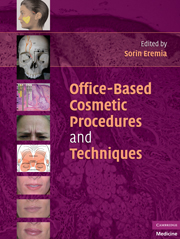Book contents
- Frontmatter
- Contents
- PREFACE
- CONTRIBUTORS
- PART ONE ANATOMY AND THE AGING PROCESS
- Chap. 1 ANATOMY AND THE AGING CHANGES OF THE FACE AND NECK
- PART TWO ANESTHESIA AND SEDATION FOR OFFICE COSMETIC PROCEDURES
- PART THREE FILLERS AND NEUROTOXINS
- PART FOUR COSMETIC APPLICATIONS OF LIGHT, RADIOFREQUENCY, AND ULTRASOUND ENERGY
- PART FIVE OTHER PROCEDURES
- INDEX
- References
Chap. 1 - ANATOMY AND THE AGING CHANGES OF THE FACE AND NECK
from PART ONE - ANATOMY AND THE AGING PROCESS
Published online by Cambridge University Press: 06 July 2010
- Frontmatter
- Contents
- PREFACE
- CONTRIBUTORS
- PART ONE ANATOMY AND THE AGING PROCESS
- Chap. 1 ANATOMY AND THE AGING CHANGES OF THE FACE AND NECK
- PART TWO ANESTHESIA AND SEDATION FOR OFFICE COSMETIC PROCEDURES
- PART THREE FILLERS AND NEUROTOXINS
- PART FOUR COSMETIC APPLICATIONS OF LIGHT, RADIOFREQUENCY, AND ULTRASOUND ENERGY
- PART FIVE OTHER PROCEDURES
- INDEX
- References
Summary
With aging, all facial elements undergo specific modifications. This results in an appearance typical for a specific age group, well recognizable by others. These signs of aging, most of which are demonstrated by Figure 1.1, which shows, split-face, the same man at ages twenty-three and fifty-one, include the following:
loss of forehead skin elasticity and subcutaneous fat, which, along with increased depressor muscles tonus, results in apparent skin redundancy and pronounced frown lines
brow ptosis
wider and deeper orbital appearance
distortion of the superolateral upper orbital rim with excess upper eyelid skin and fat (hooding)
distortion of the inferomedial orbital rim: protrusion and sagging of fat, muscles, and skin
prominent nasolabial folds
deeper and more vertically sloped nasolabial crease
loss of jawline contour with formation of jowls due to skin laxity and fat ptosis
loss of submental cervical angle: midline platysma separation and band formation, skin ptosis
These changes result in loss of the arches of the face that define the youthful appearance noted in Figure 1.2.
Such massive structural and morphological changes involve all the tissues, but each in a different way. Laxity of the skin and subcutaneous tissues accounts only for a part. Loss of volume, due to fat atrophy and bone remodeling, also contributes significantly to the aging process. Let us examine the roles of bone, fat, and muscle changes during the aging process and their consequences on appearance.
ROLE OF BONE
Human bone goes through remodeling throughout the lifetime.
- Type
- Chapter
- Information
- Office-Based Cosmetic Procedures and Techniques , pp. 3 - 6Publisher: Cambridge University PressPrint publication year: 2010



